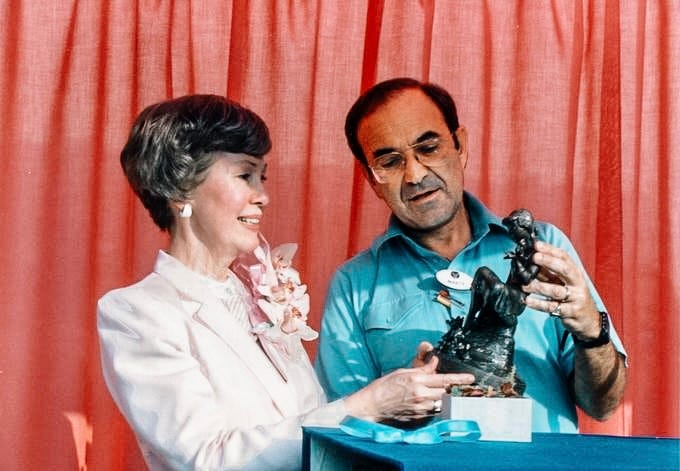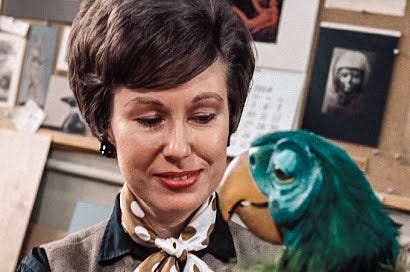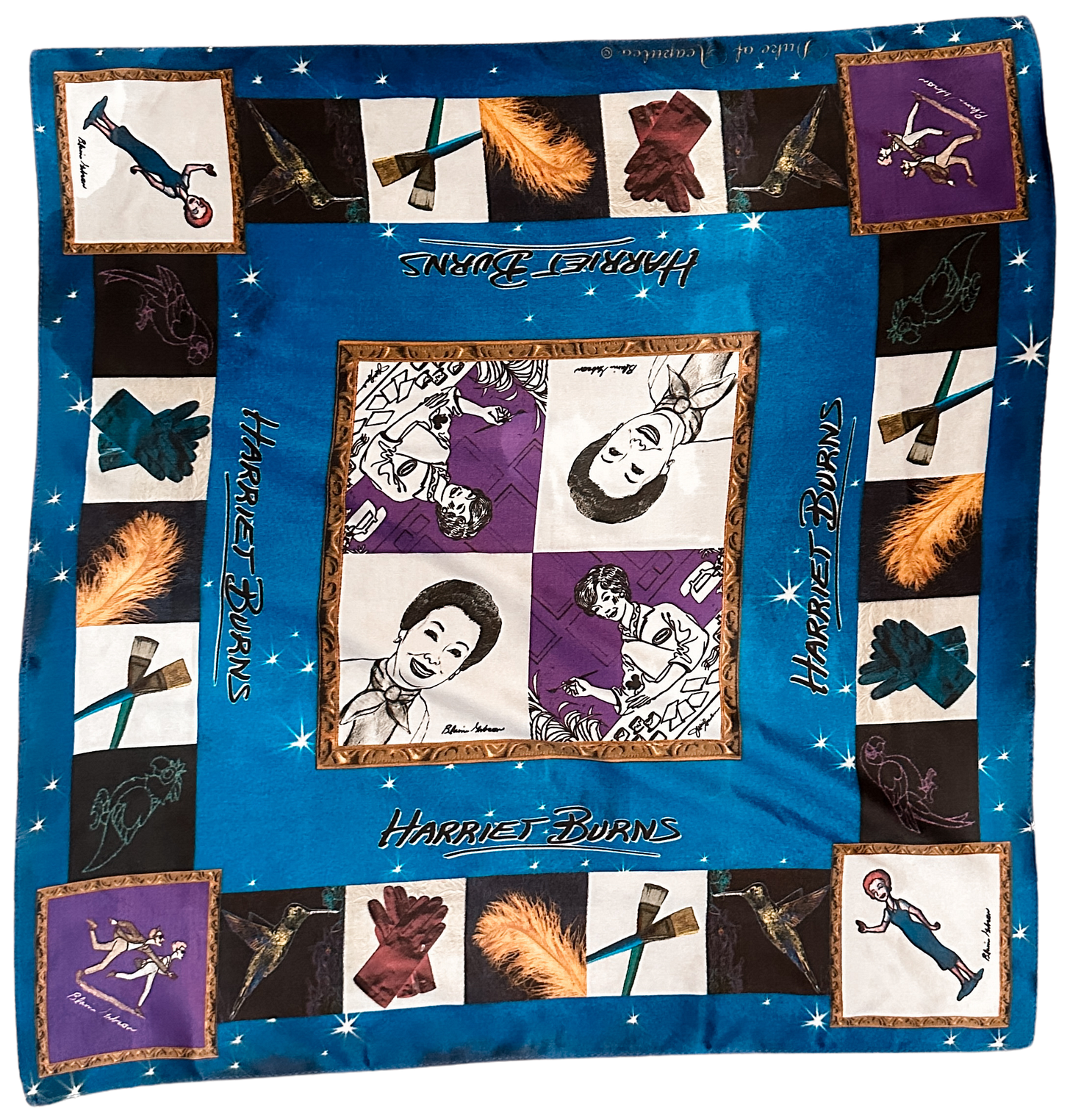The Yellow Rose of Imagineering
Queen Harriet, and why she should be one of your new favorite Imagineers
Happy Wednesday, readers! You know the question, “If you could share a meal with anyone, alive or not, who would you choose?” I’ve always had a hard time coming up with a solid response but after reading this book last summer, I’ve finally decided on my answer: the Disney Legend and former Imagineer Harriet Burns.1

Harriet sort of serendipitously stumbled into her creative role at Walt Disney Productions but managed to leave behind an incredible legacy that spanned more than 30 years in the Model Shop, which eventually became WED Enterprises (now Walt Disney Imagineering).
She was described by her colleagues as being “hilarious”, “immaculately dressed”, and “personable”, along with “nurturing” and “glowing” by those closest to her. Fellow Imagineer Alice Davis referred to Harriet as “mother superior” of the Model Shop for her supportive, understanding nature toward those she worked with, and many — including her personal accountant! — compared her to Tinkerbell and Mary Poppins because she “carried herself with poise, class, and a quiet kind of dignity.” You know, practically perfect in every way.

Perhaps most impressive of all was that Harriet was considered by many, including colleague Marty Sklar, to be Walt Disney’s favorite Imagineer.2 Michael Broggie said that it was “highly unlikely there was, or has ever been, a more popular member of the Imagineering team — certainly in the eyes of Walt.”3
There’s much to be said about Harriet — the daughter, sister, wife, mother, grandmother, friend, and colleague — and her lasting impact. For this post, however, I’ll be keeping things tight and concise to give you a crash course of sorts on our Yellow Rose of Imagineering.4
Psst! This issue is a bit too long for email so for the best reading experience, I’d recommend viewing from your go-to browser or the Substack app.
A lil’ bit about Harriet
Like myself, Harriet was a Texas girl. In fact, she was born as Harriet Tapp in San Antonio on August 20th, 1928 and raised in Seguin, which is not too far from where I call home. Part of my family has lived in or around Seguin for several decades, and I can’t help but wonder if they ever crossed paths with Harriet or her family.
Her father, Thomas “Tommy” Tapp, was an oil man previously from Atlanta, Georgia and her mom, Ivy B. Tapp, was a teacher. They met in Denver, Colorado but later moved to Texas during the oil boom in the early twentieth century. Ivy was an educator and world traveler before she became a mother and “insisted children learn Latin over their ABC’s.”

Harriet was the second-oldest out of four siblings with one older brother, Thomas Dale, and two younger sisters, Wilma and Suzie, who Harriet helped raise.
When reminiscing on her childhood, Suzie remembered how goofy and lively Harriet would be at the dinner table where the atmosphere was often solemn and serious due to news about the Second World War being relayed from the radio. Harriet would often get sent to her room without her dinner because “she just couldn’t keep quiet” or refrain from telling funny stories.
The Tapp family belonged to a “very small church” in town and when Harriet was a teenager, she was asked by the church to paint the walls of the shared nursery and choir room in a way that young children would enjoy. She landed on a jungle theme that ended up being a hit!
Harriet’s father agreed to send her to college but only on one condition: she had to choose home economics as her major. In a stroke of defiance, she ended up receiving her bachelor’s degree in art from Southern Methodist University in Dallas, Texas, where Harriet also met her husband, Bill Burns. She later went on to pursue a graduate degree in art and philosophy at the University of New Mexico in Albuquerque.
After she and Bill married in 1951, they first lived in San Angelo, Texas but eventually moved to Denver, Colorado where their daughter, Pam, was born the following year. Once Bill was deployed to Korea, Harriet and Pam stayed with the Tapps back in Texas.
On Bill’s return home from Korea, he took a pitstop in California and loved it. Not too long afterwards, the Burns family made their move to the west coast and Bill began his successful but short-lived career as an actor and screenwriter in Los Angeles. He later moved on to business; first insurance then management in the music industry and, lastly, the defense industry.
After moving to Hollywood, Harriet would always look into the windows of a prop shop called Dice Display Industries Cooperative Exchange while picking up Bill from work.5 One day, a shop manager came out and asked her if she had familiarity with prop and set design. Harriet replied that she had previously worked on some store displays at Neiman Marcus in Texas. Luckily for them both, he was looking to hire someone part-time and Harriet was looking for a lil’ extra income to support her young family. She was hired.
A short time after, Harriet began working on props to be used for television shows and theatrical productions, as well as Santa’s Village near Lake Arrowhead. Additionally, she helped create props for shows at the Dunes Hotel in Las Vegas. After the hotel refused to pay Dice Display for their work and the company had to resort to legal action, Harriet’s helper, Jim, mentioned that he still had contacts at Disney from a prior job and they were currently hiring for work on a television show for children. They both applied and were hired by Roger Broggie in 1955.
Her colorful time at WED Enterprises
This “television show for children” was none other than The Mickey Mouse Club, which premiered on ABC and ran for four consecutive seasons from 1955 to 1959. Harriet worked under Bruce Bushman, the “Father of Fantasyland”, and designed the show’s color styling and built the famous “Mouse Clubouse” in its signature modern, graphic style.

Harriet knew that she had to be as good as the boys were with lathes, table saws, drill presses, and, as she put it, “other stuff” in the Model Shop. She credited her experience at Dice Display for her ability to do so, and she knew just how to hold her own too when the inevitable misogyny surfaced and “jokes” came her way: she used her soft Texas twang to sling it right back at them.
At the time, Walt wanted three-dimensional models of everything to aid in the design process of Disneyland, so Harriet was paired with Fred Joerger, the “maestro” of the Model Shop, to start developing them when she wasn’t busy with her painting tasks for The Mickey Mouse Club sets.
Harriet’s earlier work centered on designing models for Sleeping Beauty Castle, New Orleans Square, The Haunted Mansion, Storybook Land, and the Matterhorn Bobsleds. Using reference photos from Life magazine postcards and the Encyclopedia Britannica, she designed the model for the Matterhorn but didn’t care for it “because of mathematics” (she’s just like me, for real). In fact, an official from the Smithsonian commented on their larger, 157-foot model that the overhang was a “little more than correct” but they kept it anyway and chalked it up to poetic license.
Not only was Harriet masterful at model building, but she is also credited with painting many or most of the faces of Disney — the animals, pirates, presidents, dolls, and ghouls. Additionally, Harriet designed and feathered all of the singing birds in The Enchanted Tiki Room, which was the first Audio-Animatronics attraction featured at Disneyland. Oh, and this memorable robin from this very special film?6 That was all Harriet.

When Walt was presented with the opportunity to create attractions for the 1964-1965 New York World’s Fair, it was all hands on deck. Harriet was asked to lend her creative and technical expertise to assist in the development of the Carousel of Progress (General Electric), “it’s a small world” (Pepsi Cola), Great Moments with Mr. Lincoln (State of Illinois), and the Magic Skyway (Ford Motor Company) attractions.

An impeccably dressed Harriet hard at work in the Model Shop with Disney colleagues Claude Coates and Fred Joerger. (Photo source: ImagineerHarriet.com). During development for The Haunted Mansion, Harriet was originally selected as the model for Madame Leota but after getting in the brace and taking some photos, it was decided that her features were a bit too small. So, they gave the part to Leota Toombs, who worked under Harriet. While she may not be physically represented in The Haunted Mansion, guests can see Harriet’s likeness reflected in the arms of the mother and daughter, Sarah and Patricia, on the Carousel of Progress. Yep, that’s right! Casts of Harriet’s arms were used for both.
“She got the job and things mushroomed,” Burns’ daughter, Pam Burns-Clair, said of her mother’s career. “She liked being around the creative spark, and Walt took her under his wing.”
According to Marty Sklar, “the true heartbeat of the Imagineering Model Shop was a little corner where the Queen Bee held court. No matter what time of day, you could find the big boys — even Walt — buzzing around Harriet.” Her polished presence was so integral to the shop that Walt would often feature Harriet alongside models of new areas and attractions that he would show off during segments of Walt Disney’s Wonderful World of Color, as shown below:
Harriet’s work wasn’t limited to Disneyland, though. She developed models for the Japan pavilion in Epcot’s World Showcase. In the early 80s, WED Enterprises had a program that sent Imagineers in pairs to Florida for a week to see the construction of the park firsthand. She was paired with former Imagineer Eric Jacobson, and they would stay at the Fort Wilderness Resort and Campgrounds during their visits.7
After devoting 31 years of her career to Imagineering, Harriet retired in 1986 at the age of 58. She was recognized with her very own window on Main Street, U.S.A. in Disneyland in 1992 (the first woman in Disney history to receive this honor), and was later named a Disney Legend in 2000.

In July 2008, she underwent a rather risky and complicated heart surgery in Los Angeles by the “Walt Disney of heart surgeons” to replace three valves and correct her atrial fibrillation condition. Unfortunately, she passed away due to organ failure after ten days in the intensive care unit (or “ICU”). Harriet was just shy of her 80th birthday. A week afterwards, her granddaughters said, “Gramma never wanted to be an old lady…she got her wish! She refused to turn eighty.”
Harriet’s lasting legacy
Harriet was the first non-clerical female employee of WED Enterprises, which earned her the nickname “Walt Disney’s First Lady of Imagineering”.
Her “sweet Texas drawl” and mannerisms fitted with a “twinkle and that Texas twang” were a cornerstone of her personality and presence. Harriet had “the genteel quality of a lady of Texas” and a “wonderful southern giggle.”
Ever the trendsetter, she wore “color-coordinated dresses, high-heels, and gloves” to work but hauled a “pair of slacks in a little sack” in the event she needed to climb up to out-of-reach places. Most of her suits were made by the brand Tahari.
Harriet was much more interested in hearing what others had to say than talking about herself. She made people feel seen and understood. Ted Thomas, son of animation legend Frank Thomas, mentioned that she was “always quicker to talk of her fellow artists” than gorging on details about her own life, and that everything she did was done with a “twinkle in her eye and a sparkle in her voice”. Harriet genuinely wanted to make people feel special.
“Whatever the subject, Harriet was curious and genuinely excited about it,” Disney Legend and Former Imagineer Tony Baxter said of Harriet. “Her investment in everybody around her fed the magic that flowed from her mind.”
When explaining to her goddaughter’s son how Imagineers achieved certain design tricks, specifically the lightning bugs hovering over the water at Pirates of the Caribbean, all she could muster was, “it’s Disney magic!” Harriet wasn’t spilling any beans.
Harriet was known for partaking in “off-color”, witty, and tongue-in-cheek jokes and pranks with her closest colleagues, especially Fred Joerger and his successor, Jim Sarno. Good-hearted humor could always be found in their corner of the Model Shop.
In fact, after fellow Imagineer Rolly Crump came up with a series of what he called “erotic sketches,” Harriet loved them and wanted to share them with anyone and everyone in the back of the shop. She charged them ten cents for a peek, and eventually filled an entire coffee can with dimes. Harriet knew that Rolly was saving up to buy his daughter, Roxanne, a bike and this was her way of helping him get closer to reaching that goal.

Fellow Imagineer and Disney Legend Blaine Gibson said, “I would like her to be remembered this way: she was a person that was almost indescribable in her way of affecting people. She was not just a happy, likable girl. She was a very, very smart girl that really, within her realm — I think in the sense that there was a slow acceptance of ladies — was the very first lady to be accepted in with the men on this precious thing of being a Walt Disney Imagineer and to work right alongside, not apart, but right alongside them. I would like people to remember that she was a trailblazer.”
One day in 1977, Imagineer Karen Connolly Armitage was asked by her boss where her “heels and nylons and short skirt” went that she’d been wearing earlier that day for a presentation, and added that she’d “be better served at WED if [she] went back to [her] former wardrobe” (bombastic side-eye). After running into Harriet in the bathroom and telling her what happened, Harriet “threw back her head and just howled”. With her Texas drawl, she said, “Well, if he asks you again, you just tell him that if he can come here and work for a whole two days in three-inch heels, then you will gladly put yours back on! Karen, sometimes these boys are just silly!” Karen ended up using that line the very next day.
Harriet’s scarves were her stylistic trademark at WED Enterprises so to commemorate the release of Walt Disney’s First Lady of Imagineering, Harriet Burns in 2010, fellow Imagineer Jim Sarno created a silk scarf (shown below) in her honor. It features illustrations of some of Harriet’s work, along with caricatures of her by Disney Legend Blaine Gibson and Imagineering colleague Julie Svendsen.
Last but not least…
If you’d like to purchase your own copy of Walt Disney’s First Lady of Imagineering, Harriet Burns, you can do so here. It’s a beautiful tribute to an intelligent, spunky woman who left an incredible impact on the Walt Disney Company.
I would have loved to include more photos in this post but due to copyright constraints, it just wouldn’t be possible. However, this book is loaded with over 150 photos — and numerous heartwarming stories! — from Disney, the Tapp and Burns-Clair families, and beloved friends, relations, and colleagues of Harriet that you simply cannot find elsewhere. It’s the perfect addition to any Disney history lover’s shelves.
Well, that’s all, folks! I’ve been waiting for months to write and publish this post because I truly wanted to honor Harriet in the best way that I could with the knowledge and information available to me.
Learning about her life and career has been such an incredible inspiration over the last year, and I wish for her legacy to be remembered by all who feel a connection to her timeless work and creations.
Anytime I find myself gazing up at those colorful, singing tiki birds, taking a stroll through the World Showcase at Epcot, or finally taking in the magic of Disneyland, I just know that I’ll think of my fellow Texas rose, Harriet. That, my friends, is magic, noted.
See ya real soon,
👋🏻 Lookin’ for more magic? Come say “hi” on Instagram!
☕ Help fuel those early mornings and late nights by buying me a coffee
💬 Found something in this post that resonated with you? Highlight and share it as a note to your Substack feed!
💌 Spread the magic by sending this post to a fellow Disney nerd
🗣️ Got a Substack of your own? Recommend Magic, Noted to your readers!
This belief was also supported by Evelyn “Evie” Coats, who was an employee of Walt Disney Studios, as well as the wife of Imagineer Claude Coats and mother of Alan Coats. She said, “Walt liked her because of her talent. He liked talented people.”
Burns-Clair, Pam & Peri, Don. Walt Disney’s First Lady of Imagineering: Harriet Burns. The Donning Company Publishers, 2010.
Michael Broggie is the son of Roger E. Broggie, an engineer, machinist, and head of Walt Disney Studio Machine Shop who was named a Disney Legend in 1990.
Since Harriet was a born-and-raised Texan, I’ve taken creative liberties with this nickname that’s based on a song of Texas and American folklore, “The Yellow Rose of Texas.”
Rourke, Megan. “First Female Designer for Walt Disney Imagineering.” Los Angeles Times, 30 July 2008.
The film is, of course, Mary Poppins and you can still see this very robin on display at the Carousel of Progress attraction at the Magic Kingdom in Walt Disney World.
With a career spanning over 40 years in Imagineering and executive leadership, Eric Jacobson’s portfolio includes The Great Movie Ride, Muppet*Vision 3D, The Twilight Zone Tower of Terror, Toy Story Midway Mania!, Buzz Lightyear’s Space Ranger Spin, and many more.











